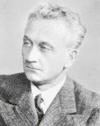- Szent-Györgyi, Albert
-
born Sept. 16, 1893, Budapest, Hung., Austria-Hungarydied Oct. 22, 1986, Woods Hole, Mass., U.S.Hungarian-born U.S. biochemist.His discoveries about the roles played by certain organic compounds, especially vitamin C, in the oxidation (see oxidation-reduction) of nutrients by cells brought him a 1937 Nobel Prize. He found and isolated an organic reducing agent from plant juices and adrenal gland extracts and showed it was identical to vitamin C. His work on intermediates in the cell laid the foundation for the elucidation of the tricarboxylic acid cycle by Hans Adolf Krebs. In later years he worked on the biochemistry of muscular action (demonstrating the role of ATP) and of cell division.
 Szent-GyörgyiBoyerH. Roger-Viollet
Szent-GyörgyiBoyerH. Roger-Viollet* * *
▪ Hungarian biochemistborn Sept. 16, 1893, Budapest, Hung., Austria-Hungarydied Oct. 22, 1986, Woods Hole, Mass., U.S.Hungarian biochemist whose discoveries concerning the roles played by certain organic compounds, especially vitamin C, in the oxidation of nutrients by the cell brought him the 1937 Nobel Prize for Physiology or Medicine.Szent-Györgyi earned a medical degree from the University of Budapest in 1917. He became interested in biochemistry and pursued studies in Germany and The Netherlands in that field. While working at the University of Cambridge (1927, 1929) and at the Mayo Foundation, Rochester, Minn., U.S. (1928), Szent-Györgyi found and isolated an organic reducing agent, which he called hexuronic acid (now known as ascorbic acid), from plant juices and adrenal gland extracts. Four years later, as a professor at the University of Szeged, Hungary (1931–45), he helped prove that the acid is identical to the antiscurvy vitamin C, which had been discovered in 1907 by Axel Holst and Alfred Fröhlich.Szent-Györgyi then turned to the study of organic compounds known to play a part in the conversion of carbohydrate breakdown products to carbon dioxide, water, and other substances necessary for the production of usable energy by the cell. His work laid the foundations for Sir Hans Krebs's elucidation of the complete conversion cycle (the Krebs cycle (tricarboxylic acid cycle)) two years later.Devoting himself to a study of the biochemistry of muscular action, he discovered a protein in muscle that he named “actin,” (actin) demonstrated that it—in combination with the muscle protein myosin—is responsible for muscular contraction, and showed that the compound adenosine triphosphate (ATP) is the immediate source of energy necessary for muscle contraction. Immigrating to the United States in 1947, he was immediately appointed director of the Institute for Muscle Research, Woods Hole, Mass., where he conducted research into the causes of cell division and, hence, cancer.Szent-Györgyi wrote The Crazy Ape (1970), a critical and pessimistic commentary on science and the prospects for human survival on Earth. Among his scientific publications are On Oxidation, Fermentation, Vitamins, Health, and Disease (1940), Chemical Physiology of Contractions in Body and Heart Muscle (1953), and Introduction to a Submolecular Biology (1960).* * *
Universalium. 2010.
